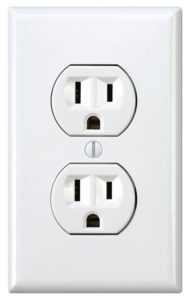 An open ground is when there is a three-prong receptacle with no equipment ground connected to it. This creates an unsafe condition because an appliance designed to be connected to an equipment ground can plug into the receptacle since it has the third slot or hole, but it will not actually have the required protection of the equipment grounding conductor.
An open ground is when there is a three-prong receptacle with no equipment ground connected to it. This creates an unsafe condition because an appliance designed to be connected to an equipment ground can plug into the receptacle since it has the third slot or hole, but it will not actually have the required protection of the equipment grounding conductor.
Open grounds are often created when an older home is upgraded, and new three-prong receptacles are installed. If the wiring connected to those receptacles is not also upgraded (and it normally isn’t upgraded), then there will be no equipment ground, and an open ground is the result.
Newer (later than 1962) homes can also have an open ground if the ground wire has become disconnected or was never connected in the first place. (In some areas, the newer electrical codes were not adopted until several years later, so it is possible that some homes built into the 1970’s will also not have grounded receptacles.)
What is the Equipment Grounding Conductor?
In residential wiring, the equipment grounding conductor (EGC) (or ground wire as many people call it) is the third wire in a three-wire system. (See wire in the left-hand photo below for a typical wire used in a 3-wire system.) The bare wire in the photo is the EGC and is connected to the round slot in an electrical outlet. (See circle on the photo below.)


All electrical devices will function properly without an equipment ground. The purpose of a ground wire or equipment grounding conductor is to make our homes safer by providing a low resistance path for fault current to flow back to the electrical panel and cause the breaker to trip. The tripping breaker will de-energize the faulty device which will prevent a shock hazard and possible electrocution.
In other words, the ground wire or EGC normally does nothing. It is not part of the normal circuit that carries electrical current. The ground wire only carries current when there is a problem with a piece of equipment (such as a toaster, refrigerator, washing machine, etc.) that is plugged into the outlet. It is quite likely that most or all of the ground wires in your home will never be used (they’ll never carry current), but they are there just in case.
Homes built before grounding was required (1960’s – 1970’s) rarely have an equipment ground – unless their electrical system was upgraded at a later date. These homes with no ground wire have what is called a “two-wire” electrical system, and normally only have two-pronged outlets.
Are Open Grounds Unsafe?
A two-wire electrical system is not as safe as a three-wire electrical system. A two-wire electrical system becomes more unsafe when it involves open grounds (ungrounded three-prong receptacles). Let me explain why.
Suppose that you have an old toaster plugged into a receptacle with an open ground. Inside that toaster, a live wire is frayed or comes loose and makes contact with the metal shell of the toaster. If someone were to touch that toaster, they could be electrocuted because the entire toaster would be energized to 120 volts. If, instead, this receptacle had been properly grounded, the breaker would have tripped as soon as the live wire made contact with the shell. The tripping breaker would have de-energized the toaster, preventing a possible electrocution.
(Here is a post that explains how to make open grounds and ungrounded outlets safe.)
© 2020 Mike Morgan
This article was written by Mike Morgan, the owner of Morgan Inspection Services. Morgan Inspection Services has been providing home, septic and well inspection services throughout the central Texas area since 2002. He can be reached at 325-998-4663 or at mike@morganinspectionservices.com. No article, or portion thereof, may be reproduced or copied without prior written consent of Mike Morgan.

